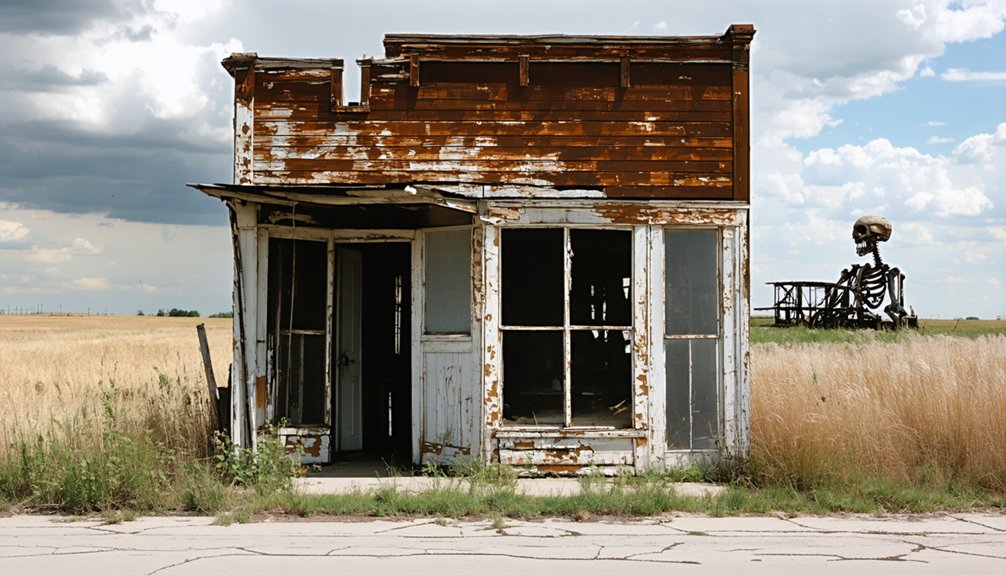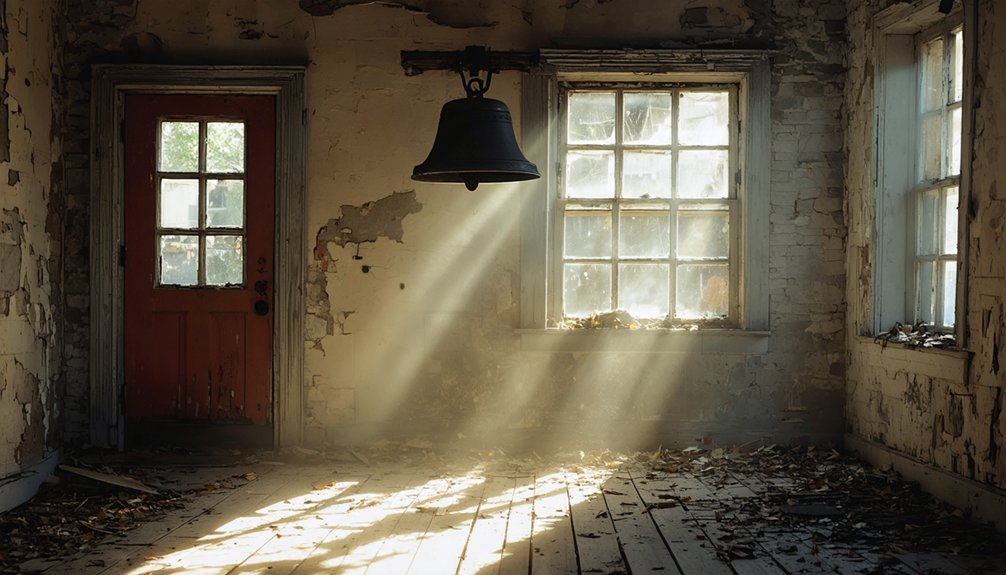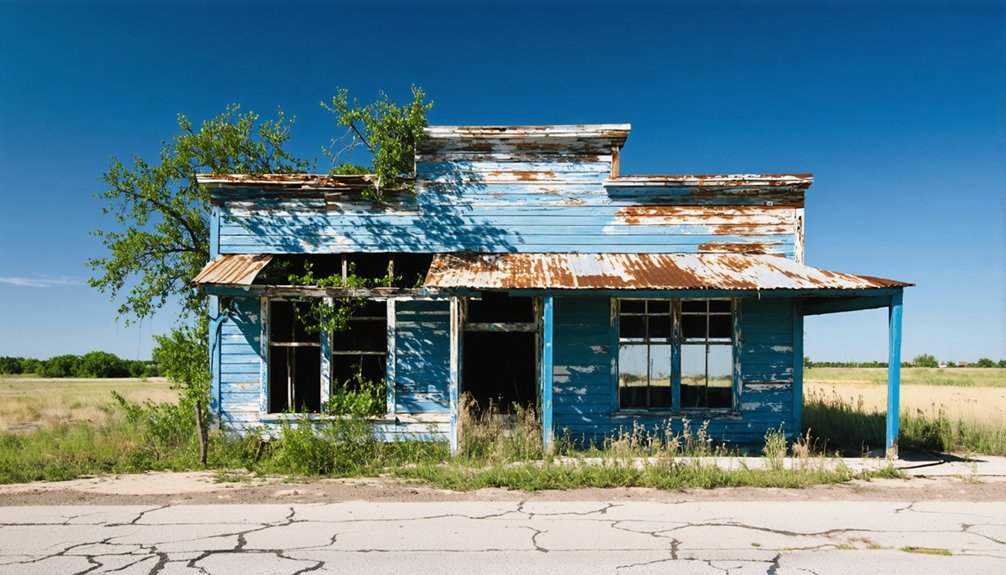You’ll find Carlton, Texas as a ghost town that once thrived with 750 residents during its 1910 railroad heyday. Founded in 1877, it flourished as an essential cotton shipping point after the Stephenville North and South Texas Railway arrived in 1907. Today, you can explore its architectural legacy through abandoned structures like the original bank vault, Model-T era gas station, and 1969-shuttered schoolhouse. Each empty building tells a story of rural Texas prosperity and decline.
Key Takeaways
- Carlton, Texas peaked in 1910 with 750 residents but declined after economic shifts, agricultural mechanization, and transportation route changes.
- Founded in 1877, the town flourished with the arrival of Stephenville North and South Texas Railway in 1907.
- Historic structures including a bank vault, cotton gin, churches, and Model-T gas station remain as architectural testament.
- The town’s economy centered on cotton production until the Dust Bowl and post-World War II changes led to population exodus.
- Many original stone and mortar buildings stand abandoned, preserving rural Texas architectural features from the 19th century.
Early Settlement and Town Origins
As the Texas frontier expanded in the late 19th century, Carlton emerged as a promising settlement when H.H. Armstrong founded the town in 1877.
The settlement patterns centered on land owned by rancher J.M. Evans and Dr. F.M. Carlton, with the latter becoming the town’s namesake. You’ll find that early community dynamics took shape quickly, driven by the town’s strategic location on a major stagecoach line. The arrival of the Stephenville North and South Texas Railway brought new opportunities for growth and commerce.
By 1878-1879, Carlton had established core institutions including churches, a school, and a post office, reflecting the determination of its pioneer residents.
The town’s economic foundation rested firmly on cotton production and ranching interests, attracting settlers who saw opportunity in the fertile land. The area’s success in cotton production helped the population grow significantly from 150 to 750 residents between 1907 and 1910. This agricultural focus would shape Carlton’s development and set the stage for its rapid growth in the coming decades.
Railroad’s Impact on Growth
When the Stephenville, North and South Texas Railway arrived in Carlton in 1907, it transformed the town’s economic prospects and connectivity.
You’ll find that this railroad significance went far beyond mere transportation – it became Carlton’s lifeline to the wider Texas economy.
The railway’s presence enabled Carlton to establish itself as an essential shipping point for cotton, livestock, and grain.
You’d have seen the town’s economic connectivity strengthen as new cotton gins and agricultural processing facilities sprang up near the tracks.
While Carlton didn’t grow as explosively as towns with multiple rail lines like Carrollton, the railroad helped stabilize its population and sustain its agricultural economy throughout the early 1900s.
The rail depot became a focal point, concentrating the town’s commercial activity around this critical transportation link.
Like Carrollton’s three diamond crossings that formed by 1908, Carlton’s rail infrastructure played a crucial role in shaping local development.
A devastating flood in spring 1990 would have significantly impacted Carlton’s rail operations, much as it did to other Texas rail lines during that period.
Cotton Industry and Economic Peak
While Spanish missionaries first cultivated cotton in Texas during the early 1700s, Carlton’s cotton industry truly emerged with Anglo-American settlers in the 1820s.
You’d find cotton production flourishing in the fertile bottomlands between the Brazos and Colorado rivers, where Stephen F. Austin’s colonists established thriving plantations. The region’s output contributed to Texas producing $500,000 worth of cotton annually by 1835.
The crop-lien system created significant hardships for local farmers, as many found themselves trapped in a cycle of perpetual debt to landowners.
Daily Life in Early Carlton
You’d find Carlton’s social life centered around its churches and schools, where community members gathered regularly for events, celebrations, and weekly services.
During the cotton season, you’d witness the town spring to life as farmers and workers crowded the streets, conducting business at the bank and stores while hauling their cotton to the gin.
The Stephenville railway line brought increased commerce and visitors to the bustling town in the early 1900s.
The weekly newspapers, the *Courier* and later the *Citizen*, kept you informed of these local happenings, from social events to cotton prices and market conditions. Unlike other towns with similar names, Carlton, Texas needed disambiguation guidance to distinguish it from other Carlton locations.
Community Gatherings and Events
During the early 1900s, Carlton’s social fabric centered around its churches, schools, and local businesses, which served as essential gathering spots for the growing community.
You’d find residents congregating at multiple churches for Sunday services, weddings, and holiday celebrations that strengthened social bonds throughout the town.
The local school hosted plays and educational fairs, while two weekly newspapers – the Courier and the Citizen – kept you informed of upcoming community events and local happenings.
The general store and post office weren’t just places of commerce; they served as daily meeting points where you’d catch up on news and connect with neighbors. Like the German immigrants who rebuilt their lives after leaving Indianola, the townspeople formed tight-knit social circles that supported one another.
The town reached its peak with a population of 750 residents during the cotton industry boom between 1907 and 1910, creating a vibrant atmosphere for community activities.
Seasonal celebrations and festivals, often tied to holidays and harvest times, brought everyone together in shared traditions.
Cotton Industry Work Life
As cotton emerged as Carlton’s economic backbone in the early 1900s, the industry relied heavily on tenant farmers and sharecroppers who endured grueling sunup-to-sundown workdays.
You’d find entire families, including children as young as four, working the fields under the scorching Texas sun. While landowners lived comfortably in nearby towns, tenant farming kept workers trapped in cycles of poverty, rarely breaking even after settling accounts.
Mexican laborers, earning just $1.00 per day, joined the workforce by the 1920s, fleeing revolution in their homeland.
You’d see them alongside former slaves and their descendants, all performing backbreaking manual labor in harsh conditions. The demanding schedule left little time for education or family life, creating a stark divide between field workers and the landowners who profited from their toil.
Forces Behind the Town’s Decline

While Carlton once thrived as a bustling agricultural community in the early 20th century, several interconnected forces led to its eventual decline and ghost town status.
Economic shifts and demographic changes dealt severe blows to the town’s significance, particularly after World War II.
You’ll find these key factors shaped Carlton’s fate:
- Dramatic agricultural decline, including the impacts of the Dust Bowl and reduced need for farm labor due to mechanization
- Loss of critical transportation routes as highways and railroads were rerouted away from the town
- Steady population exodus as residents moved to urban areas seeking better opportunities
- Weakening tax base that couldn’t sustain essential community services and infrastructure
These challenges created a downward spiral that transformed Carlton from a vibrant community into a ghost town by 1980.
Architectural Legacy and Landmarks
You’ll find Carlton’s architectural legacy expressed through locally-sourced stone and mortar buildings constructed during the late 19th and early 20th centuries, including the still-standing bank with its original vault and several commercial structures built around the town’s crossroads.
The town’s layout evolved around key landmarks that remain today, such as the Carlton Baptist Church, the Model-T era gas station, and the 1969-shuttered schoolhouse.
While many structures now stand abandoned or repurposed, they preserve essential features of rural Texas architecture, from utilitarian commercial buildings to wood-frame houses with upstairs living quarters.
Historic Building Construction Methods
The architectural legacy of Carlton’s historic buildings reveals sophisticated construction methods that defined small-town Texas development in the 19th and early 20th centuries.
You’ll find durability at the core of every structure, with stone and brick load-bearing walls providing stability, while timber framing offered versatile solutions for homes and shops. The town’s builders mastered functional design through lime mortar applications and precise metal hardware installations.
- Stone walls up to two feet thick regulated indoor temperatures through scorching summers
- Gabled roofs with generous overhangs protected against harsh Texas weather
- Strategically placed windows and doorways created natural cross-ventilation
- Local materials and architectural simplicity reflected frontier practicality
These climate adaptations and construction techniques have enabled many structures to withstand over a century of exposure to the elements.
Notable Surviving Structures
Several notable structures stand as evidence to Carlton’s historic building methods, offering a window into the town’s vibrant past.
You’ll find the surviving architecture includes a bank building with its original vault still visible, and an abandoned cotton gin that speaks to the town’s agricultural heritage.
The historical significance of Carlton’s religious landscape remains apparent through two surviving church buildings, including Carlton Baptist Church and an old Church of Christ structure.
The Model-T era gas station, though missing its pumps, stands as a reflection of early automotive culture.
Stone and mortar commercial buildings line the streets, while preserved residential structures, including a former seamstress shop with sewing machines still in the windows, paint a picture of daily life in this once-thriving community.
Town Layout Evolution
Founded in 1877 near essential travel and freight routes, Carlton’s layout evolved from a strategic crossroads at FM Roads 219 and 1744 into a well-planned community hub.
The town’s agricultural layout centered around its economic lifeline – cotton production – with supporting infrastructure strategically positioned along major transportation routes.
You’ll find these key features shaped Carlton’s development:
- Commercial district clustered at the crossroads, housing the bank, stores, and essential services
- Residential areas positioned near the town center, supporting workers and farming families
- Public buildings, including churches and schools, formed the civic core
- Industrial structures like the cotton gin and freight facilities aligned with transportation routes
The town’s footprint contracted considerably after 1980 as the population declined to 70, leaving many historic buildings vacant or repurposed.
Stories From Former Residents
While Carlton’s crumbling buildings tell one story, former residents paint a vivid picture of a once-bustling community where cotton gins hummed and Model-T Fords rattled down dusty streets.
Through former memories of a thriving population that peaked at 750 residents in 1910, you’ll hear tales of a vibrant small-town life centered around schools, churches, and a local newspaper.
Back when Carlton bustled with 750 souls, life revolved around schoolyard laughter, church bells, and fresh ink on newsprint.
Community tales reveal the dramatic transformation from prosperity to decline, particularly after the railroad’s abandonment in 1940.
You can sense the disappointment in residents’ accounts as they watched their town’s opportunities slip away. Their stories capture Carlton frozen in time – a place where locked buildings still hold remnants of a more prosperous era, and empty streets echo with memories of bustling commerce and social gatherings.
Exploring Carlton Today

Today’s visitors to Carlton encounter a haunting tableau of abandoned buildings and quiet streets, where roughly 70 residents maintain a tenuous connection to this once-prosperous community.
Located 85 miles southwest of Fort Worth, this relic of ghost town tourism offers a raw glimpse into early 20th-century Texas life.
When exploring Carlton’s historical preservation sites, you’ll discover:
- Weathered structures from the town’s cotton-industry heyday, including former newspaper offices and commercial buildings
- The historic Cotton Belt Route railway path that once brought prosperity to the region
- Original church buildings and school facilities, now standing silent
- Remnants of the stagecoach line that connected Carlton to major trade routes
You’ll need your own vehicle to access the site, as no public transportation serves this remote location.
Preserving a Piece of Texas History
Despite Carlton’s dwindling population, preservation efforts have emerged through a blend of private stewardship and informal community care.
You’ll find historic buildings like the old bank, cotton gin, and stone-built stores locked and maintained by owners who use them for storage, helping to slow their deterioration.
While Carlton hasn’t established formal community initiatives like the Victorian Tea Parties or heritage festivals seen in neighboring ghost towns, there’s potential to adopt these proven preservation models.
The town faces significant preservation challenges, including limited funding and the natural decay of aging structures.
However, you can see how private ownership of these historic properties offers opportunities for future restoration projects, potentially transforming Carlton into a cultural destination while protecting its authentic Texas heritage.
Frequently Asked Questions
Are There Any Ghost Stories or Paranormal Activities Reported in Carlton?
You won’t find documented ghost sightings or haunted locations in Carlton. While abandoned buildings might spark speculation about paranormal activity, there aren’t any verified reports or established local legends here.
What Were the Most Common Causes of Death in Carlton’s Early Years?
Like autumn leaves falling too soon, you’d find disease outbreaks claimed most lives in Carlton, with influenza, tuberculosis, and typhoid fever leading the toll, followed by farming and railroad accidents.
Did Any Famous Outlaws or Historical Figures Ever Visit Carlton?
You won’t find documented outlaw encounters or historical visits from famous figures in Carlton’s history. The town’s records focus on local founders like Dr. F.M. Carlton and everyday settlers instead.
What Native American Tribes Originally Inhabited the Carlton Area?
Beneath vast prairie skies, you’d find the powerful Wichita, Caddo, and Comanche tribes dominating the area’s tribal history. These native cultures thrived here, with Tonkawa hunters and Cherokee settlers arriving later.
How Many Original Carlton Buildings Are Still Standing and Structurally Sound?
You’ll find multiple original buildings still standing, though they lack historic preservation efforts. Without official surveys, it’s unclear how many are structurally sound enough for building restoration to be feasible.
References
- https://www.amysatticss.com/ghost-towns/
- https://en.wikipedia.org/wiki/Carlton
- https://www.youtube.com/watch?v=LB75k_yCwrM
- https://www.ctpost.com/news/slideshow/Ghost-towns-around-Texas-95681.php
- https://www.ghosttowns.com/states/tx/carlton.html
- https://en.wikipedia.org/wiki/List_of_ghost_towns_in_Texas
- https://www.texasescapes.com/CentralTexasTownsNorth/CarltonTexas.htm
- https://www.thetravel.com/which-state-has-the-most-ghost-towns/
- https://www.youtube.com/watch?v=OWowj-QJlTE
- https://txprobatelawyer.net/the-rise-of-ghost-towns-can-you-own-a-piece-of-abandoned-texas/



